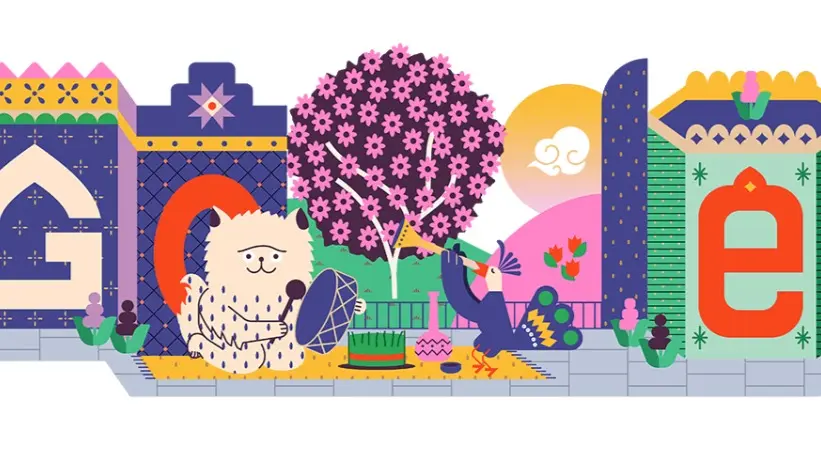Updated 19 March 2024 at 13:16 IST
Google celebrates Nowruz 2024 with new Doodle for 13 countries
Nowruz, meaning ‘new day’ in Persian, aligns with the vernal equinox, heralding the onset of spring in the Northern Hemisphere.
- Tech News
- 4 min read

Google Doodle for Nowroz: Google marked the arrival of Nowruz, the Persian New Year, on March 19th with a captivating Doodle on its homepage. In the Doodle, Nowroz is depicted with an illustration of animal friends who have gathered in a flower-filled courtyard to ring in the coming of spring under the blossoming tree.
Google’s Nowroz Doodle on March 19 | Image credit: Google.in
Nowruz, meaning ‘new day’ in Persian, aligns with the vernal equinox, heralding the onset of spring in the Northern Hemisphere. The Doodle featured vibrant Persian cultural motifs, including intricate floral patterns, calligraphy, and symbolic Haft-sin table items.
Advertisement
According to Google’s official blog, the annual festival of Nowroz has been around for over 3,000 years and as time went on, several countries and ethnic groups along the Silk Roads started adopting the tradition.
“During Nowruz, the most important tradition is the haft-sīn. Families gather and set out seven items that each represent renewal and rejuvenation. These items usually include wheat for rebirth and good fortune, wheat pudding for power and strength, olive for love, berries for the sunrise, vinegar for age and patience, apple for beauty, and garlic for good health,” Google wrote in the blog.
Advertisement
What is Nowroz and why is it celebrated?
Nowroz, also known as Persian New Year, marks the beginning of spring and the first day of the Iranian calendar. Celebrated by various communities worldwide, it symbolises renewal, hope, and the victory of light over darkness. Nowroz festivities include elaborate feasts, family gatherings, and cultural events, often lasting for several days.
Traditional table setting during Nowruz | Image credit: RDNE Stock project/Pexels
Ancient myth credits King Jamshid with founding Nowroz to commemorate his reign and the end of winter's darkness. He introduced the solar calendar, marking the vernal equinox as the beginning of the new year.
According to local folklore, the tradition of setting up a Haft-Seen table during Nowroz originated from the story of Zoroastrian priest Zarathustra, who adorned his home with seven symbolic items for prosperity and abundance.
The common traditions in Nowroz include cleaning homes, decorating with flowers, and exchanging gifts. Haji Firuz, a beloved character in Nowroz celebrations, is said to symbolise the arrival of spring and the renewal of nature. Legend has it that he spreads joy and laughter through music, dance, and humorous antics.
Who made the Google’s Nowruz Doodle?
This Doodle was created by Iranian guest artist Pendar Yousefi, a Californa-based Iranian UX designer, currently leading the global design team at Google Translate. Explaining his creative process for Nowroz Doodle, Yousefi said, “As I learned more about the rich tapestry of Nowruz traditions across different communities, it became clear that capturing them all in one Doodle would be a challenge. So, my process involved a lot of research into the Nowruz customs and artistic traditions of these communities.”
Pendar Yousefi | Image credit: Mahimoto.com
Yousefi chose illuminated manuscripts as the visual language as the core theme of the design as it is a part of the artistic heritage across the regions that celebrate Nowruz.
“These are captured through the animal friends who have gathered in a flower-filled courtyard to ring in the coming of spring under the blossoming tree. Even in challenging times, the spirit of Nowruz - the promise of renewal and a 'new day' on the horizon - offers a beacon of hope,” Yousefi said describing the theme.
Countries in which Google’s Nowruz Doodle will be visible
Interestingly, not all Google Doodles are visible across the globe due to cultural sensitivities, legal restrictions, or regional celebrations. Google adapts its Doodles to local customs and regulations, sometimes leading to variations or exclusions in certain regions to avoid controversy or offence while respecting local traditions and laws.
Image credit: Google Doodle blog
On March 19, Google’s Nowruz Doodle is visible in India and 12 other countries including Canada, the United States, the United Kingdom, Iceland, Kazakhstan, Pakistan, Afghanistan, Uzbekistan, Azerbaijan, Tajikistan, Kyrgyzstan, and Turkmenistan.
Published By : Anirudh Trivedi
Published On: 19 March 2024 at 11:56 IST
